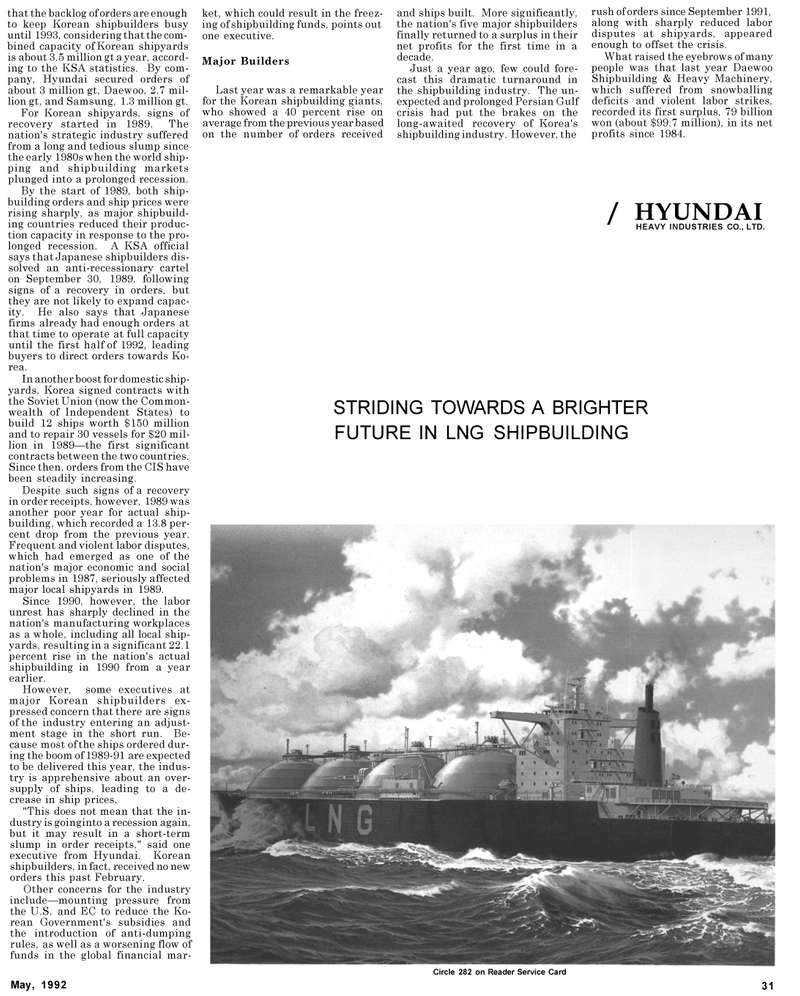
Page 31: of Maritime Reporter Magazine (May 1992)
Read this page in Pdf, Flash or Html5 edition of May 1992 Maritime Reporter Magazine
that the backlog of orders are enough to keep Korean shipbuilders busy until 1993, considering that the com- bined capacity of Korean shipyards is about 3.5 million gt a year, accord- ing to the KSA statistics. By com- pany, Hyundai secured orders of about 3 million gt, Daewoo, 2.7 mil- lion gt, and Samsung, 1.3 million gt.
For Korean shipyards, signs of recovery started in 1989. The nation's strategic industry suffered from a long and tedious slump since the early 1980s when the world ship- ping and shipbuilding markets plunged into a prolonged recession.
By the start of 1989, both ship- building orders and ship prices were rising sharply, as major shipbuild- ing countries reduced their produc- tion capacity in response to the pro- longed recession. A KSA official says that Japanese shipbuilders dis- solved an anti-recessionary cartel on September 30, 1989, following signs of a recovery in orders, but they are not likely to expand capac- ity. He also says that Japanese firms already had enough orders at that time to operate at full capacity until the first half of 1992, leading buyers to direct orders towards Ko- rea.
In another boost for domestic ship- yards, Korea signed contracts with the Soviet Union (now the Common- wealth of Independent States) to build 12 ships worth $150 million and to repair 30 vessels for $20 mil- lion in 1989—the first significant contracts between the two countries.
Since then, orders from the CIS have been steadily increasing.
Despite such signs of a recovery in order receipts, however, 1989 was another poor year for actual ship- building, which recorded a 13.8 per- cent drop from the previous year.
Frequent and violent labor disputes, which had emerged as one of the nation's major economic and social problems in 1987, seriously affected major local shipyards in 1989.
Since 1990, however, the labor unrest has sharply declined in the nation's manufacturing workplaces as a whole, including all local ship- yards, resulting in a significant 22.1 percent rise in the nation's actual shipbuilding in 1990 from a year earlier.
However, some executives at major Korean shipbuilders ex- pressed concern that there are signs of the industry entering an adjust- ment stage in the short run. Be- cause most of the ships ordered dur- ing the boom of 1989-91 are expected to be delivered this year, the indus- try is apprehensive about an over- supply of ships, leading to a de- crease in ship prices. "This does not mean that the in- dustry is goinginto a recession again, but it may result in a short-term slump in order receipts," said one executive from Hyundai. Korean shipbuilders, in fact, received no new orders this past February.
Other concerns for the industry include—mounting pressure from the U.S. and EC to reduce the Ko- rean Government's subsidies and the introduction of anti-dumping rules, as well as a worsening flow of funds in the global financial mar-
May, 1992 ket, which could result in the freez- ing of shipbuilding funds, points out one executive.
Major Builders
Last year was a remarkable year for the Korean shipbuilding giants, who showed a 40 percent rise on average from the previous year based on the number of orders received and ships built. More significantly, the nation's five major shipbuilders finally returned to a surplus in their net profits for the first time in a decade.
Just a year ago, few could fore- cast this dramatic turnaround in the shipbuilding industry. The un- expected and prolonged Persian Gulf crisis had put the brakes on the long-awaited recovery of Korea's shipbuilding industry. However, the rush of orders since September 1991, along with sharply reduced labor disputes at shipyards, appeared enough to offset the crisis.
What raised the eyebrows of many people was that last year Daewoo
Shipbuilding & Heavy Machinery, which suffered from snowballing deficits and violent labor strikes, recorded its first surplus, 79 billion won (about $99.7 million), in its net profits since 1984. / HYUNDAI
HEAVY INDUSTRIES CO., LTD.
STRIDING TOWARDS A BRIGHTER
FUTURE IN LNG SHIPBUILDING
Circle 282 on Reader Service Card 31

 30
30

 32
32
